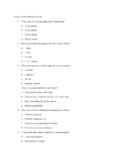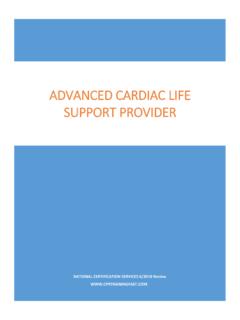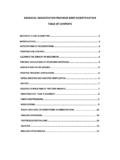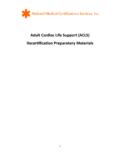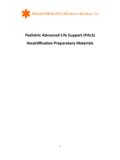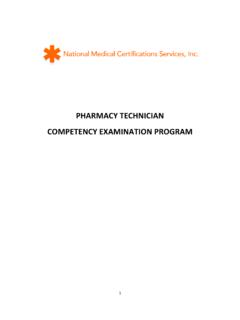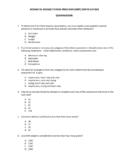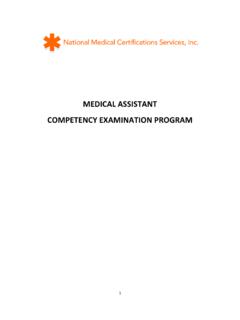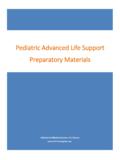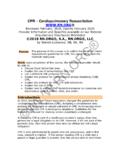Transcription of the first drug you should administer? 2. Which of the ...
1 1. You are called to help resuscitate an infant with severe symptomatic bradycardia associated with respiratory distress. The bradycardia persists despite establishment of an effective airway, oxygenation, and ventilation. There is no heart block present. Which of the following is the first drug you should administer? A. Atropine B. Dopamine C. Adenosine D. Epinephrine 2. Which of the following statements about the effects of epinephrine during attempted resuscitation is true? A. Epinephrine decreases peripheral vascular resistance and reduces myocardial afterload so that ventricular contractions are more effective B.
2 Epinephrine improves coronary artery perfusion pressure and stimulates spontaneous contractions when asystole is present C. Epinephrine is contraindicated in ventricular fibrillation because it increases myocardial irritability D. Epinephrine decreases myocardial oxygen consumption 3. General assessment of a 2-year-old female reveals her to be alert with mild breathing difficulty during inspiration and pale skin color. On primary assessment, she makes high-pitched inspiratory sounds (mild stridor) when agitated; otherwise her breathing is quiet.
3 Her SpO2 is 92% in room air, and she has mild inspiratory intercostal retractions. Lung auscultation reveals transmitted upper airway sounds with adequate distal breath sounds bilaterally. Which of the following is the most appropriate initial therapy intervention for this child? A. Perform immediate endotracheal intubation B. Administer an IV dose of dexamethasone C. Nebulize mg of albuterol D. Administer humidified supplementary oxygen as tolerated and continue evaluation 4. Which of the following most reliably delivers a high (90% or greater) concentration of inspired oxygen in a toddler or older child?
4 A. Nasal cannula with 4 L/min oxygen flow B. Simple oxygen mask with 15 L/min oxygen flow C. Nonrebreathing face mask with 12 L/min oxygen flow D. Face tent with 15 L/min oxygen flow 5. Which of the following statements about endotracheal drug administration is true? A. Endotracheal drug administration is the preferred route of drug administration during resuscitation because it results in predictable drug levels and drug effects B. Endotracheal doses of resuscitation drugs in children have been well established and are supported by evidence from clinical trials C.
5 Intravenous drug doses for resuscitation drugs should be used whether you give the drugs by the IV, intraosseous (IO), or the endotracheal route D. Endotracheal drug administration is the least desirable route of administration because this route results in unpredictable drug levels and effects 6. Which of the following statements most accurately reflects the PALS recommendations for the use of magnesium sulfate in the treatment of cardiac arrest? A. Magnesium sulfate is indicated for VF refractory to repeated shocks and amiodarone or lidocaine B.
6 Routine use of magnesium sulfate is indicated for shock-refractory monomorphic VT C. Magnesium sulfate is indicated for torsades de pointes or suspected hypomagnesemia D. Magnesium sulfate is contraindicated in VT associated with an abnormal QT interval during the preceding sinus rhythm 7. You enter a room to perform a general assessment of a previously stable 10-yearold male and find him unresponsive and apneic. A code is called and bag-mask ventilation is performed with 100% oxygen. The cardiac monitor shows a widecomplex tachycardia.
7 The boy has no detectable pulses. You deliver an unsynchronized shock with 2 J/kg. The rhythm check after 2 minutes of CPR reveals VF. You then deliver a shock of 4 J/kg and resume immediate CPR beginning with compressions. A team member had established IO access, so you give a dose of epinephrine, mg/kg ( mL/kg of 1:10,000 dilution) IO when CPR is restarted after the second shock. At the next rhythm check, persistent VF is present. You administer a 4 J/kg shock and resume CPR. Based on the PALS Pulseless Arrest Algorithm, what are the next drug and dose to administer when CPR is restarted?
8 A. Epinephrine mg/kg ( mL/kg of 1:1,000 dilution) IO B. Atropine mg/kg IO C. Amiodarone 5 mg/kg IO D. Magnesium sulfate 25 to 50 mg/kg IO 8. Parents of a 1-year-old female phoned the Emergency Response System when they picked up their daughter from the baby-sitter. Paramedics perform a general assessment revealing an obtunded infant with irregular breathing, bruises over the abdomen, abdominal distention, and cyanosis. Assisted bag-mask ventilation with 100% oxygen is initiated. On primary assessment heart rate is 36/min, peripheral pulses cannot be palpated, and central pulses are barely palpable.
9 Cardiac monitor shows sinus bradycardia. Chest compressions are started with a 15:2 compression to-ventilation ratio. In the emergency department the infant is intubated and ventilated with 100% oxygen, and IV access is established. The heart rate is now up to 150/min but there are weak central pulses and no distal pulses. Systolic blood pressure is 74 mm Hg. Of the following, Which would be most useful in management of this infant? A. Epinephrine mg/kg ( mL/kg of 1:10,000 dilution) IV B. Rapid bolus of 20 mL/kg of isotonic fluid C.
10 Atropine mg/kg IV D. Synchronized cardioversion 9. Which of the following statements about calcium is true? A. Routine administration of calcium is not indicated during cardiac arrest. B. The recommended dose is 1 to 2 mg/kg of calcium chloride C. Calcium chloride 10% has the same bioavailability of elemental calcium as calcium gluconate in critically ill children D. Indications for administration of calcium include hypercalcemia, hypokalemia, and hypomagnesemia 10. An infant with a history of vomiting and diarrhea arrives by ambulance.
